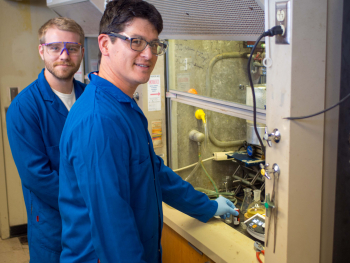
School:
Grade Level:
Teaching Position:
Supervisor:
Department:
Mentor:
Research Project Year:
Research Project Title:
Research Project Description:
Polymer chemistry is a far reaching research area that has changed the world over the last century. Polymers are very adaptable molecules that can be made with seemingly infinite variety and quality. There is much interest in making polymers that have increased control and efficacy and the goal of this research project is to characterize a specific polymer synthesis reaction catalyst called a photoacid. Once this polymer synthesis method is standardized, a library of polymers with different molecular weights, building blocks, and functional characteristics will be developed. Photoacids that undergo proton dissociation upon irradiation with light are particularly interesting and promise spatial and temporal control of these processes in a noncontact way. The Bates group is trying to increase the solubility of a specific photoacid to increase the breadth of polymer synthesis. Specifically, the goal of this project is to quantify the solubility of the photoacid for future use in polymer synthesis and characterization. Another goal of the lab is to investigate applications of fluorinated polymers for their unusually high hydrophobicity. After the reaction components are characterized, a library of different polymers will be analyzed for functionality.
Curriculum Project Year:
Curriculum Project Title:
Curriculum Project Description:
This unit is designed for grades nine through twelve and looks at the intermolecular forces involved in plastic manufacture. Plastic is part of nearly every aspect of life. Despite the ubiquitous nature of plastics, high school students know very little about the science involved. This unit is designed to give students an appreciation of the versatility of plastics, have students design and execute experiments to better understand the nature of plastics, and engineer a product made of plastic. In the Starch Plastic Lab, students will vary the molecular weight and amount of plasticizer in their plastics and test mechanical strength and viscosity. Students will draw on the information learned from lab to make a plastic toy. In the last part of the unit, student will examine and model the chemical reactions involved in addition polymerization. They will have to model the three steps involved in polymerization, initiation, propagation, and termination.
